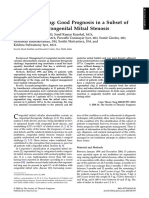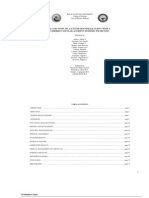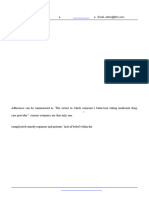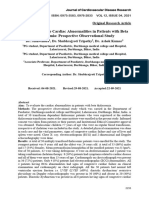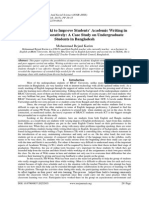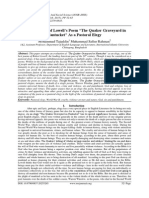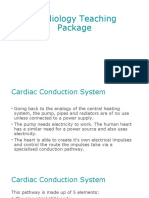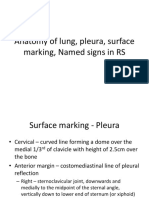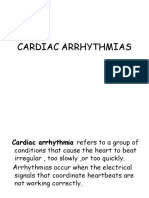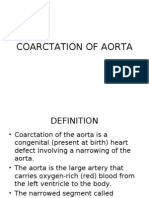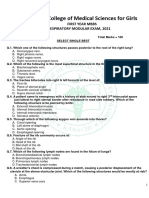Coronary Dominance in Fetuses of Manipuri Origin
Coronary Dominance in Fetuses of Manipuri Origin
Uploaded by
IOSRjournalCopyright:
Available Formats
Coronary Dominance in Fetuses of Manipuri Origin
Coronary Dominance in Fetuses of Manipuri Origin
Uploaded by
IOSRjournalOriginal Description:
Copyright
Available Formats
Share this document
Did you find this document useful?
Is this content inappropriate?
Copyright:
Available Formats
Coronary Dominance in Fetuses of Manipuri Origin
Coronary Dominance in Fetuses of Manipuri Origin
Uploaded by
IOSRjournalCopyright:
Available Formats
IOSR Journal of Dental and Medical Sciences (IOSR-JDMS)
e-ISSN: 2279-0853, p-ISSN: 2279-0861.Volume 14, Issue 7 Ver. III (July. 2015), PP 55-59
www.iosrjournals.org
Coronary Dominance in Fetuses of Manipuri Origin
Bidyarani Yumnam1, Aribam Jaishree Devi2,
Nongthombam Saratchandra Singh3.
1: Postgraduate student,2: Associate professor,3: Professor, Department of Anatomy,
Regional Institute of Medical Sciences, Imphal, Manipur, India.
Abstract: The cardiovascular system is the first organ system of an embryo to reach a functional state. The
heart is supplied by the right and left coronary arteries which arise from the ascending aorta. The artery giving
off the posterior interventricular branch is defined as the dominant artery. Materials and method: Thirty fetal
hearts ranging from gestational age of 17 wks to 40 wks are studied. Results and observation: Right dominance
in 70%, left dominance in 20% and co dominant in 10%. Myocardial bridges are also a common finding in the
course of the arteries. Conclusion: This study provides potentially useful information for the preoperative
evaluation of the newborn.
Keywords: coronary artery, fetal hearts, dominance, co dominant or balanced, myocardial bridges.
I.
Introduction
The cardiovascular system is the first major system to function in the embtyo. The primordial heart and
vascular system appear in the middle of the third week. 1The normal coronary vasculature of the embryonic
human heart begins as a group of epi-cardial blood islands, endothelium-lined cysts filled with nucleated
erythrocytes, in the apical interventricular sulcus. Coronary artery arises normally only from the juxtapulmonary
aortic sinuses.2
The right and left coronary arteries arise from the ascending aorta. The right coronary artery gives off
the conus artery as its first branch. The right marginal artery is long enough to reach the apex in most hearts. As
the right coronary approaches the crux of the heart, it normally produces one to three posterior interventricular
branches (occasionally there are none). One, of them lies in the interventricular groove as the posterior
interventricular artery. The left coronary divides into two or three main branches. The anterior interventricular
artery is commonly described as the continuation of left coronary artery. The left diagonal artery reach the
rounded (obtuse) left border. The circumflex artery, comparable to the anterior interventricular artery in calibre,
curves left in the atrioventricular groove, continuing round the left cardiac border into the posterior part of the
groove and ending left of the crux in most hearts, but sometimes continuing as a posterior interventricular
artery.3The artery giving off the posterior interventricular branch is defined as the dominant artery. In a balanced
circulation, branches of both arteries run in or near the posterior interventricular groove. 4 The dominant artery is
usually the right in 67% of the population. In approximately 15% of hearts the left coronary artery is dominant
in that the posterior interventricular artery is a branch of the circumflex artery. There is co-dominance in
approximately 18% of people, in which branches of both the right and left coronary artery reach the crux of the
heart and give rise to branches that course in or near the posterior interventricular groove. 5 Anastomoses
betwesen right and left coronary arteries are abundant during fetal life, but are much reduced by the end of the
first year of life.3
The situation of coronary arteries is usually subepicardial, but can delve into the myocardium and then
reappear on the surface of the heart. Thus the bundle of myocardial fibre which overlaps one segment of
coronary artery is defined the myocardial bridge. 6
Knowledge of the normal and variant anatomy and anomalies of coronary circulation is an increasingly
vital component in the management of congenital and acquired heart diseases. Congential, inflammatory,
metabolic and degenerative diseases may involve the coronary circulation and increasingly complex cardiac
surgical repairs demand enhanced understanding of the basic anatomy to improve the operative outcomes.7
II.
Materials And Method
Thirty fetuses of gestational age of 17 weeks to 40 weeks are collected from the department of
Obstetrics and Gynaecology,RIMS. Prior to collection of fetuses permission is sought from the Institutional
Ethics Committee. The fetuses are categorised into 4 groups randomly depending on their gestational age as
group 1, group 2, group 3 and group 4 ranging from 17 weeks to 22 weeks, 23 weeks to 28 weeks, 29 weeks to
34 weeks and 35 weeks to 40 weeks of gestation respectively (Fig 1). The fetuses are then fixed in 10%
formalin. The thorax is opened to remove the heart. Gross anatomy of the heart is studied and the coronary
arteries are traced to their termination. Photographs of relevant areas are taken.
DOI: 10.9790/0853-14735559
www.iosrjournals.org
55 | Page
Coronary Dominance In Fetuses Of Manipuri Origin
III.
Results And Observation
In group 1, right dominance is observed in 2 specimens and co-dominance in 1 specimen. In group 2,
right dominance is seen in 2 specimens and 3 specimens show left dominance. In group 3, right dominance is
seen in 8 specimens, 2 specimens shows left dominance and 1 shows co-dominance. In group 4, right
dominance is seen in 9 specimens, 1 specimen shows left dominance and 1 shows co-dominance. Out of the
total 30 fetal heart specimens right dominance is observed in 21, left dominance in 6 and co-dominance in 3 of
the specimens (Fig 2, Fig 3, Fig 4).
The site of the termination of right coronary artery is also taken into consideration and it is observed
that the artery terminates at the right acute border in 16.6% (5 no.), between the right border and crux in 3.3% (1
no.), at the crux in 13.3% (4 no.), between the crux and left obtuse border in43.3% (13 no.) and at the left obtuse
border in 23.3% (7 no.).
Myocardial bridge is also a very common observation in many of the fetal hearts in the present study
(Fig 5). It is seen in 36.6% (11 no.) of the heart specimen.
IV.
Discussion
The present study observes 70%, 20% and 10% respectively of right dominance, left dominance and
co-dominance in the fetal heart specimens. It is also observed that the right coronary artery crosses crux of the
heart and lie near or at the obtuse border in 66.6% of the study sample.
In a study done by Kandregula J et al it was seen that the percentage incidence of dominance based on
the origin of posterior interventricular branch in a sample of aborted fetuses were 56%, 38% and 6%
respectively for right, left and balanced dominance.8 In their findings left dominancy was reported higher as
compared to the present study. This is the only available study done on fetuses regarding cardiac dominancy,
other studies are done on adults.
Right coronary dominancy was found to be the most frequently observed in studies conducted by most
of the authors. Shukri IG et al reported that 65% was right dominant circulation, 27% mixed circulation and 8%
were left dominant circulation.9 In a study done by Kalpana R, the Right coronary artery was the dominant
artery in 89% and the Left in 11% of the specimens. 7 Fazliogullari Z et al reported that coronary dominance of
all hearts were 42%, 14% and 44% respectively of right dominance, left dominance and equal dominance. 10
They reported a higher incidence of equal dominance as compared to the present study. In an Assamese
population, Das H et al reported 70% were right dominant, 18.5% and 11.43% were left dominant and codominant respectively.11 The findings of Das H et al are closer to the findings of present study. Reddy VJ et al
reported that in a South Indian population right dominance was 86.25%, left dominance was 11.26% and codominant was 2.5%.19
The overall prevalence of the myocardial bridging was found to be 70% in the study sample of
Swaroop N et al. They reported that myocardial bridges were distributed more over left coronary artery in right
dominant hearts. The anatomical relation of the myocardial fibres in those with long and deep myocardial
bridges can distort the coronary artery that can be identified angiographically. The possibility of bridges should
be borne in mind in individuals with ischemia but no evidence of coronary atherosclerosis. 12
The possible clinical implications of myocardial bridging may vary from protection against
atherosclerosis to systolic vessel compression and resultant myocardial ischaemia as reported by Loukas M et al.
The coronary dominance of all of the hearts in their study was as follows: 55% were right dominant, 33% left
dominant and 12% codominant; 66.6% of the hearts with bridges were left dominant. 13
Myocardial bridging has been associated with angina, myocardial infarction, and sudden death.
Ironically, the bridged segment is rarely affected by atherosclerosis and can easily go unrecognised on cine
arteriography as what otherwise appears to be a normal coronary artery.14
Kura GG et al also reported a case of myocardial bridge in the branches of left coronary artery, which
showed a trifurcation of anterior interventricular, left circumflex and median artery. 15
Abuchaim DCS et al also reported 72%, 20% and 8% of right dominant, left dominant and codominant
respectively. He also reported that no anastomosis were present between the two coronary system in their study
sample.16
In patients referred for Computed tomography coronary angiography a left dominant coronary artery
system was identified as a significant risk factor for myocardial infarction and death. Particularly in the
subgroup of patients with significant coronary artery disease on computed tomography coronary angiography,
those patients with a left dominant coronary artery system had a strongly increased risk of events compared with
patients with a right dominant coronary artery system. Therefore, the potential indication for intensive treatment
could be more prominent in patients with a left dominant coronary artery system.17
DOI: 10.9790/0853-14735559
www.iosrjournals.org
56 | Page
Coronary Dominance In Fetuses Of Manipuri Origin
V.
Conclusion
The present study concludes that in fetuses of Manipuri origin which is ethnically and racially different
from the mainland Indians, in the majority of the heart i.e in 70% of the sample the right coronary artery is the
dominant artery. However further studies are suggested in a larger study sample and the association of
myocardial bridges in the course of coronary artery. This study will be of value to surgeons while undergoing
coronary intervention in the newborn.
Photograph
CODOMINANCE
RIGHT
LEFT
35-40
wks
29-34
wks
23-28
wks
17-22
wks
Fig 1: specimens of fetal heart arranged according to gestational age
RIGHT CORONARY ARTERY
POSTERIOR INTERVENTRICULAR
ARTERY
Fig 2: Diaphragmatic surface of heart
showing right dominance
LEFT DOMINANCE
LEFT CORONARY ARTERY
POSTERIOR INTERVENTRICULAR
ARTERY
Fig 3: Left dominance
DOI: 10.9790/0853-14735559
www.iosrjournals.org
57 | Page
Coronary Dominance In Fetuses Of Manipuri Origin
LEFT CORONARY ARTERY
RIGHT CORONARY ARTERY
POSTERIOR INTERVENTRICULAR
ARTERY
Fig 4: Balance pattern
MYOCARDIAL BRIDGE
Fig 5: Myocardial bridge in the course of right coronary artery
GESTATIONAL AGE IN
WEEKS
17-22
23-28
29-34
35-40
RESULTS
RIGHT DOMINANT
LEFT DOMINANT
BALANCED PATTERN
2
2
8
9
1
1
1
3
2
1
Table1: Result of the present study
STUDY
PRESENT
JAMES 18
FISS DM14
ABUCHAIM DCS 16
DAS H11
FAZLIOGULL ARI SZ10
REDDY VJ19
SHUKRI IG9
KALPANA R7
LOUKAS M13
COMPARISONS WITH THE RESULT OF OTHER AUTHOR
RIGHT DOMINANCE
LEFT DOMINANCE
BALANCE
PATTERN
70%
20%
10%
95.34%
85%
8%
7%
72%
20%
8%
70%
18.57%
14.43%
42%
14%
44%
86.25%
11.26%
2.5%
65%
27%
8%
89%
11%
55%
33%
12%
Table 2: Table showing the comparison of the present study with other study
DOI: 10.9790/0853-14735559
www.iosrjournals.org
58 | Page
Coronary Dominance In Fetuses Of Manipuri Origin
References
[1].
[2].
[3].
[4].
[5].
[6].
[7].
[8].
[9].
[10].
[11].
[12].
[13].
[14].
[15].
[16].
[17].
[18].
[19].
Moore KL, Persuad TVN, Torchia MG. The developing human. 8th ed. Philadelphia: Saunders; 2008.
Hutchins GM, Kessler-Hanna A, Moore GW. Development of the coronary arteries in the embryonic human heart. Pathophysiology
and natural history Embryonic heart development 1988 Jun;77(6): 1250-57
Gatzoulis MA. Thorax. In: Standring S, Borley NR, Crossman AR, Healy JC, John D, Mahadevan V, Newell RLM, editors. Grays
Anatomy. 40th ed Philadelphia: Churchill Livingstone; 2008.p.907-1013.
Sinnatamby CS. Lasts Anatomy. 12th ed. Edinburg: Churchill Livingstone; 2011.
Moore KL, Dalley AF, Agur AMR. Moore clinically oriented embryology. 7th ed. New Delhi: Lippincott Williams & Wilkins;2014.
Fazliogullari Z, Karabulut AK, Kayrak M, Uysal II, Dogan NU, Altunkeser BB. Investigation and review of myocardial bridges in
adult cadaver hearts and angiographs. Surgical and radiologic anatomy 2010;32(5):775-80.
Kalpana R. A study on principal branches of coronary arteries in humans. J Anat. Soc. India 2003; 52(2) 137-140.
Kandregula J, Velichety SD, Karla T, Sreevaram HH, Chilumu J, Mohammad R. Morphological and morphometric parameters of
coronary arteries in human foetal hearts. Int J Res Health Sci 2014; 2(1):126-32.
Shukri IG, Hawas JM, Karim SH, Ali IKM. Angiographic study of the normal coronary artery in patients attending Ulaimani center
for heart Diseases. EJS 2014; 10(24): 384-415.
Fazliogullari Z, Karbulut AK, Unver DN, Uysal II. Coronary artery variations and median artery in Turkish cadaver hearts.
Singapore Med J 2010; 51(10): 775-80.
Das H, Das G, Das DC, Talukdar K. A study of coronary dominance in the population of Assam. J Anat Soc 2010;59(2):187-91.
Swaroop N, Poornima GC, Shashanka MJ. Study of myocardial bridges in the hearts of the human cadavers.GJMR:Surgeries and
cardiovascular system 2014;14(1): 25-28.
Loukas M, Curry B, Bowers M, Louis Jr RG, Bartczak A, Keidrowski M, Kamionek M, Fudalei M, Wagner T. The relationship of
myocardial bridges to coronary artery dominance in the adult human heart. J Anat 2006 Jul;209(1):43-50.
Fiss DM. Normal coronary artery and anatomic variation.2007;13.Available at:URL:http://www.applied radiology .com. Accessed
October,15,2013.
Kura GG, Poerschke RA, Tumelero RT, Merlin AP. Myocardial bridges and left coronary artery trifurcation: a case report. J
Morpholo Sci 2013;30(3):209-11.
Abuchaim DCS, Spera CA, Faroco DL, Filho JMR, Malafaia O. Coronary dominance patterns in the human heart investigated by
corrosion casting. Rev Bras Cir Cardiovasc 2009;24(4):514-18.
Veltman CE, de Graaf FR, Schuijf JD, van Werkhoven JM, Jukema JW, Kauffmann PA. Prognostic value of coronary vessel
dominance in relation to significant coronary artery disease determined with non invasive computed tomography coronary
angiography. Euro Heart J 2012;33:1367-77.
James TN, Burch GE. Blood supply of the human interventricular septum. Circulation 1958;17:391-96.
Reddy VJ, Lokanadham S. Coronary dominance in South Indian population. Int J Med Res Health Sci 2013;2(1):78-82.
DOI: 10.9790/0853-14735559
www.iosrjournals.org
59 | Page
You might also like
- The WHO Manual of Diagnostic Imaging Radiographic Anatomy and Interpretation of The Chest and The Pulmonary System100% (2)The WHO Manual of Diagnostic Imaging Radiographic Anatomy and Interpretation of The Chest and The Pulmonary System154 pages
- 27-30 Sudden Death of A Premature New-Born With Hypoplastic Left Heart Syndrome. Morfological Study of The HeartNo ratings yet27-30 Sudden Death of A Premature New-Born With Hypoplastic Left Heart Syndrome. Morfological Study of The Heart4 pages
- Situs Inversus Imaging - Practice Essentials, Radiography, Computed TomographyNo ratings yetSitus Inversus Imaging - Practice Essentials, Radiography, Computed Tomography9 pages
- Fetal Cardiac Dextroposition in The Absence of An Intrathoracic MassNo ratings yetFetal Cardiac Dextroposition in The Absence of An Intrathoracic Mass8 pages
- Anatomical Study of Coronary Arteries and Its Braching Pattern in Costal Andhra Pradesh PopulationNo ratings yetAnatomical Study of Coronary Arteries and Its Braching Pattern in Costal Andhra Pradesh Population17 pages
- Paper - Hypoplastic Left Heart SyndromeNo ratings yetPaper - Hypoplastic Left Heart Syndrome22 pages
- Atrial Septal Defect in An Elderly Dog: (Comunicação)No ratings yetAtrial Septal Defect in An Elderly Dog: (Comunicação)5 pages
- 129926-Article Text-351546-1-10-20160203No ratings yet129926-Article Text-351546-1-10-201602035 pages
- Takayasu arteritis with SLE - A rare associationNo ratings yetTakayasu arteritis with SLE - A rare association4 pages
- Study On Clinical Presentation and Etiological ProNo ratings yetStudy On Clinical Presentation and Etiological Pro6 pages
- Study of Various Cardiac Arrhythmias in Patients of Acute Myocardial InfarctionNo ratings yetStudy of Various Cardiac Arrhythmias in Patients of Acute Myocardial Infarction10 pages
- Prenatal Diagnosis - 2008 - Yao - Prenatal Diagnosis of Mitral Atresia With Atrial Septal Defect of The Septum Primum ANo ratings yetPrenatal Diagnosis - 2008 - Yao - Prenatal Diagnosis of Mitral Atresia With Atrial Septal Defect of The Septum Primum A2 pages
- Thyroidectomy - StatPearls - NCBI BookshelfNo ratings yetThyroidectomy - StatPearls - NCBI Bookshelf12 pages
- EBSTEIN'S ANOMALY Dhini - Maju 17 Juli 2014No ratings yetEBSTEIN'S ANOMALY Dhini - Maju 17 Juli 201429 pages
- Aortic Atresia With Normally Developed Left Ventricle in A Young AdultNo ratings yetAortic Atresia With Normally Developed Left Ventricle in A Young Adult3 pages
- An Anomalous Right Coronary Artery Draining Into The Left Ventricle Through A FistulaNo ratings yetAn Anomalous Right Coronary Artery Draining Into The Left Ventricle Through A Fistula5 pages
- Adult Congenital Heart Disease in Clinical PracticeFrom EverandAdult Congenital Heart Disease in Clinical PracticeDoreen DeFaria YehNo ratings yet
- Morphology and Variations of Renal Artery Pattern: A Case ReportNo ratings yetMorphology and Variations of Renal Artery Pattern: A Case Report3 pages
- Early Myocardial Deformation Changes in Hypercholesterolemic and Obese Children and AdolescentsNo ratings yetEarly Myocardial Deformation Changes in Hypercholesterolemic and Obese Children and Adolescents10 pages
- Pathophysiology, Diagnosis, and Medical Management of Nonsurgical PatientsNo ratings yetPathophysiology, Diagnosis, and Medical Management of Nonsurgical Patients14 pages
- Assessment of The Cardiac Abnormalities in Patients With Beta Thalassemia Prospective Observational StudyNo ratings yetAssessment of The Cardiac Abnormalities in Patients With Beta Thalassemia Prospective Observational Study7 pages
- Intracardiac Metastasis of Hepatocellular Carcinoma:about A Rare CaseNo ratings yetIntracardiac Metastasis of Hepatocellular Carcinoma:about A Rare Case4 pages
- Left Atrial Volume Predicts Cardiovascular EventsNo ratings yetLeft Atrial Volume Predicts Cardiovascular Events6 pages
- Full download (Ebook) Pediatric Imaging Cases (Cases in Radiology) by Ellen Chung ISBN 9780199758968, 0199758964 pdf docx100% (1)Full download (Ebook) Pediatric Imaging Cases (Cases in Radiology) by Ellen Chung ISBN 9780199758968, 0199758964 pdf docx67 pages
- A Study of Renal Artery Variations in Cadavers: Ephraim Vikram Rao K, Sadananda Rao BattulaNo ratings yetA Study of Renal Artery Variations in Cadavers: Ephraim Vikram Rao K, Sadananda Rao Battula7 pages
- Case Reports of Left Atrial Myxoma in Elderly and ChildrenNo ratings yetCase Reports of Left Atrial Myxoma in Elderly and Children5 pages
- 34 - Imaging Diagnosis of Situs Inversus, Persistence of The LeftNo ratings yet34 - Imaging Diagnosis of Situs Inversus, Persistence of The Left4 pages
- Surgical Anatomy of Thyroid and Incidence of Malignancy in Solitary Nodule of ThyroidNo ratings yetSurgical Anatomy of Thyroid and Incidence of Malignancy in Solitary Nodule of Thyroid7 pages
- Myocardial Bridges Over Interventricular Branches of Coronary Arteries100% (1)Myocardial Bridges Over Interventricular Branches of Coronary Arteries4 pages
- A Morphological Study of Anatomical Variations in 96 Circles of Willis An Autopsic Evaluation and Literature ReviewNo ratings yetA Morphological Study of Anatomical Variations in 96 Circles of Willis An Autopsic Evaluation and Literature Review6 pages
- Lethal Arrhythmias: Advanced Rhythm Interpretation: This Course Has Been Awarded Five (5) Contact HoursNo ratings yetLethal Arrhythmias: Advanced Rhythm Interpretation: This Course Has Been Awarded Five (5) Contact Hours45 pages
- An Autopsy Study of Coronary AtherosclerosisNo ratings yetAn Autopsy Study of Coronary Atherosclerosis6 pages
- Lobulated Spleen With A Fissure On Diaphragmatic Surface: RD RDNo ratings yetLobulated Spleen With A Fissure On Diaphragmatic Surface: RD RD7 pages
- Detection of Intra-Cardiac Thrombi and Congestive Heart Failure in Cats PDFNo ratings yetDetection of Intra-Cardiac Thrombi and Congestive Heart Failure in Cats PDF11 pages
- Beating with Precision: The Science of Cardiology: Understand the Intricacies of the Human HeartFrom EverandBeating with Precision: The Science of Cardiology: Understand the Intricacies of the Human HeartNo ratings yet
- Attitude and Perceptions of University Students in Zimbabwe Towards HomosexualityNo ratings yetAttitude and Perceptions of University Students in Zimbabwe Towards Homosexuality5 pages
- Socio-Ethical Impact of Turkish Dramas On Educated Females of Gujranwala-PakistanNo ratings yetSocio-Ethical Impact of Turkish Dramas On Educated Females of Gujranwala-Pakistan7 pages
- "I Am Not Gay Says A Gay Christian." A Qualitative Study On Beliefs and Prejudices of Christians Towards Homosexuality in ZimbabweNo ratings yet"I Am Not Gay Says A Gay Christian." A Qualitative Study On Beliefs and Prejudices of Christians Towards Homosexuality in Zimbabwe5 pages
- A Review of Rural Local Government System in Zimbabwe From 1980 To 2014No ratings yetA Review of Rural Local Government System in Zimbabwe From 1980 To 201415 pages
- A Proposed Framework On Working With Parents of Children With Special Needs in SingaporeNo ratings yetA Proposed Framework On Working With Parents of Children With Special Needs in Singapore7 pages
- The Role of Extrovert and Introvert Personality in Second Language AcquisitionNo ratings yetThe Role of Extrovert and Introvert Personality in Second Language Acquisition6 pages
- Assessment of The Implementation of Federal Character in Nigeria.No ratings yetAssessment of The Implementation of Federal Character in Nigeria.5 pages
- Comparative Visual Analysis of Symbolic and Illegible Indus Valley Script With Other LanguagesNo ratings yetComparative Visual Analysis of Symbolic and Illegible Indus Valley Script With Other Languages7 pages
- The Impact of Technologies On Society: A Review100% (1)The Impact of Technologies On Society: A Review5 pages
- Topic: Using Wiki To Improve Students' Academic Writing in English Collaboratively: A Case Study On Undergraduate Students in BangladeshNo ratings yetTopic: Using Wiki To Improve Students' Academic Writing in English Collaboratively: A Case Study On Undergraduate Students in Bangladesh7 pages
- Investigation of Unbelief and Faith in The Islam According To The Statement, Mr. Ahmed MoftizadehNo ratings yetInvestigation of Unbelief and Faith in The Islam According To The Statement, Mr. Ahmed Moftizadeh4 pages
- Edward Albee and His Mother Characters: An Analysis of Selected PlaysNo ratings yetEdward Albee and His Mother Characters: An Analysis of Selected Plays5 pages
- Relationship Between Social Support and Self-Esteem of Adolescent GirlsNo ratings yetRelationship Between Social Support and Self-Esteem of Adolescent Girls5 pages
- An Evaluation of Lowell's Poem "The Quaker Graveyard in Nantucket" As A Pastoral ElegyNo ratings yetAn Evaluation of Lowell's Poem "The Quaker Graveyard in Nantucket" As A Pastoral Elegy14 pages
- Importance of Mass Media in Communicating Health Messages: An AnalysisNo ratings yetImportance of Mass Media in Communicating Health Messages: An Analysis6 pages
- Designing of Indo-Western Garments Influenced From Different Indian Classical Dance CostumesNo ratings yetDesigning of Indo-Western Garments Influenced From Different Indian Classical Dance Costumes5 pages
- Beowulf: A Folktale and History of Anglo-Saxon Life and CivilizationNo ratings yetBeowulf: A Folktale and History of Anglo-Saxon Life and Civilization3 pages
- Human Rights and Dalits: Different Strands in The DiscourseNo ratings yetHuman Rights and Dalits: Different Strands in The Discourse5 pages
- Role of Madarsa Education in Empowerment of Muslims in IndiaNo ratings yetRole of Madarsa Education in Empowerment of Muslims in India6 pages
- Classical Malay's Anthropomorphemic Metaphors in Essay of Hikajat AbdullahNo ratings yetClassical Malay's Anthropomorphemic Metaphors in Essay of Hikajat Abdullah9 pages
- Extracardiac Fontan With Direct Inferior Vena Cava To Main Pulmonary Artery Connection Without Cardiopulmonary BypassNo ratings yetExtracardiac Fontan With Direct Inferior Vena Cava To Main Pulmonary Artery Connection Without Cardiopulmonary Bypass4 pages
- 12 - Semiotics of Cardiovascular Disorders. Semiotics of Congenital Hert Diseases in Children.No ratings yet12 - Semiotics of Cardiovascular Disorders. Semiotics of Congenital Hert Diseases in Children.30 pages
- Cardiology Discharge Summary Escription Edited FileNo ratings yetCardiology Discharge Summary Escription Edited File4 pages
- Advanced Echocardiography For The Critical Care Physician - Part 2No ratings yetAdvanced Echocardiography For The Critical Care Physician - Part 28 pages
- ECG Interpretation Course - Nursing Continuing EducationNo ratings yetECG Interpretation Course - Nursing Continuing Education46 pages
- 12-Lead ECG Interpretation - NSER-7210-NET - Emergency Nursing Theory 2 (X-List 202230)No ratings yet12-Lead ECG Interpretation - NSER-7210-NET - Emergency Nursing Theory 2 (X-List 202230)1 page
- Anatomy of Lung, Pleura, Surface MarkingNo ratings yetAnatomy of Lung, Pleura, Surface Marking22 pages
- Buddiga, 2014 Cardiovascular System Anatomy - Overview, Gross Anatomy, Natural VariantsNo ratings yetBuddiga, 2014 Cardiovascular System Anatomy - Overview, Gross Anatomy, Natural Variants13 pages
- Respiratory System Activity: What A Bunch of Grapes100% (1)Respiratory System Activity: What A Bunch of Grapes2 pages
- The WHO Manual of Diagnostic Imaging Radiographic Anatomy and Interpretation of The Chest and The Pulmonary SystemThe WHO Manual of Diagnostic Imaging Radiographic Anatomy and Interpretation of The Chest and The Pulmonary System
- 27-30 Sudden Death of A Premature New-Born With Hypoplastic Left Heart Syndrome. Morfological Study of The Heart27-30 Sudden Death of A Premature New-Born With Hypoplastic Left Heart Syndrome. Morfological Study of The Heart
- Situs Inversus Imaging - Practice Essentials, Radiography, Computed TomographySitus Inversus Imaging - Practice Essentials, Radiography, Computed Tomography
- Fetal Cardiac Dextroposition in The Absence of An Intrathoracic MassFetal Cardiac Dextroposition in The Absence of An Intrathoracic Mass
- Anatomical Study of Coronary Arteries and Its Braching Pattern in Costal Andhra Pradesh PopulationAnatomical Study of Coronary Arteries and Its Braching Pattern in Costal Andhra Pradesh Population
- Atrial Septal Defect in An Elderly Dog: (Comunicação)Atrial Septal Defect in An Elderly Dog: (Comunicação)
- Study On Clinical Presentation and Etiological ProStudy On Clinical Presentation and Etiological Pro
- Study of Various Cardiac Arrhythmias in Patients of Acute Myocardial InfarctionStudy of Various Cardiac Arrhythmias in Patients of Acute Myocardial Infarction
- Prenatal Diagnosis - 2008 - Yao - Prenatal Diagnosis of Mitral Atresia With Atrial Septal Defect of The Septum Primum APrenatal Diagnosis - 2008 - Yao - Prenatal Diagnosis of Mitral Atresia With Atrial Septal Defect of The Septum Primum A
- Aortic Atresia With Normally Developed Left Ventricle in A Young AdultAortic Atresia With Normally Developed Left Ventricle in A Young Adult
- An Anomalous Right Coronary Artery Draining Into The Left Ventricle Through A FistulaAn Anomalous Right Coronary Artery Draining Into The Left Ventricle Through A Fistula
- Adult Congenital Heart Disease in Clinical PracticeFrom EverandAdult Congenital Heart Disease in Clinical Practice
- Morphology and Variations of Renal Artery Pattern: A Case ReportMorphology and Variations of Renal Artery Pattern: A Case Report
- Early Myocardial Deformation Changes in Hypercholesterolemic and Obese Children and AdolescentsEarly Myocardial Deformation Changes in Hypercholesterolemic and Obese Children and Adolescents
- Pathophysiology, Diagnosis, and Medical Management of Nonsurgical PatientsPathophysiology, Diagnosis, and Medical Management of Nonsurgical Patients
- Assessment of The Cardiac Abnormalities in Patients With Beta Thalassemia Prospective Observational StudyAssessment of The Cardiac Abnormalities in Patients With Beta Thalassemia Prospective Observational Study
- Intracardiac Metastasis of Hepatocellular Carcinoma:about A Rare CaseIntracardiac Metastasis of Hepatocellular Carcinoma:about A Rare Case
- Full download (Ebook) Pediatric Imaging Cases (Cases in Radiology) by Ellen Chung ISBN 9780199758968, 0199758964 pdf docxFull download (Ebook) Pediatric Imaging Cases (Cases in Radiology) by Ellen Chung ISBN 9780199758968, 0199758964 pdf docx
- A Study of Renal Artery Variations in Cadavers: Ephraim Vikram Rao K, Sadananda Rao BattulaA Study of Renal Artery Variations in Cadavers: Ephraim Vikram Rao K, Sadananda Rao Battula
- Case Reports of Left Atrial Myxoma in Elderly and ChildrenCase Reports of Left Atrial Myxoma in Elderly and Children
- 34 - Imaging Diagnosis of Situs Inversus, Persistence of The Left34 - Imaging Diagnosis of Situs Inversus, Persistence of The Left
- Surgical Anatomy of Thyroid and Incidence of Malignancy in Solitary Nodule of ThyroidSurgical Anatomy of Thyroid and Incidence of Malignancy in Solitary Nodule of Thyroid
- Myocardial Bridges Over Interventricular Branches of Coronary ArteriesMyocardial Bridges Over Interventricular Branches of Coronary Arteries
- A Morphological Study of Anatomical Variations in 96 Circles of Willis An Autopsic Evaluation and Literature ReviewA Morphological Study of Anatomical Variations in 96 Circles of Willis An Autopsic Evaluation and Literature Review
- Lethal Arrhythmias: Advanced Rhythm Interpretation: This Course Has Been Awarded Five (5) Contact HoursLethal Arrhythmias: Advanced Rhythm Interpretation: This Course Has Been Awarded Five (5) Contact Hours
- Lobulated Spleen With A Fissure On Diaphragmatic Surface: RD RDLobulated Spleen With A Fissure On Diaphragmatic Surface: RD RD
- Detection of Intra-Cardiac Thrombi and Congestive Heart Failure in Cats PDFDetection of Intra-Cardiac Thrombi and Congestive Heart Failure in Cats PDF
- Beating with Precision: The Science of Cardiology: Understand the Intricacies of the Human HeartFrom EverandBeating with Precision: The Science of Cardiology: Understand the Intricacies of the Human Heart
- Attitude and Perceptions of University Students in Zimbabwe Towards HomosexualityAttitude and Perceptions of University Students in Zimbabwe Towards Homosexuality
- Socio-Ethical Impact of Turkish Dramas On Educated Females of Gujranwala-PakistanSocio-Ethical Impact of Turkish Dramas On Educated Females of Gujranwala-Pakistan
- "I Am Not Gay Says A Gay Christian." A Qualitative Study On Beliefs and Prejudices of Christians Towards Homosexuality in Zimbabwe"I Am Not Gay Says A Gay Christian." A Qualitative Study On Beliefs and Prejudices of Christians Towards Homosexuality in Zimbabwe
- A Review of Rural Local Government System in Zimbabwe From 1980 To 2014A Review of Rural Local Government System in Zimbabwe From 1980 To 2014
- A Proposed Framework On Working With Parents of Children With Special Needs in SingaporeA Proposed Framework On Working With Parents of Children With Special Needs in Singapore
- The Role of Extrovert and Introvert Personality in Second Language AcquisitionThe Role of Extrovert and Introvert Personality in Second Language Acquisition
- Assessment of The Implementation of Federal Character in Nigeria.Assessment of The Implementation of Federal Character in Nigeria.
- Comparative Visual Analysis of Symbolic and Illegible Indus Valley Script With Other LanguagesComparative Visual Analysis of Symbolic and Illegible Indus Valley Script With Other Languages
- Topic: Using Wiki To Improve Students' Academic Writing in English Collaboratively: A Case Study On Undergraduate Students in BangladeshTopic: Using Wiki To Improve Students' Academic Writing in English Collaboratively: A Case Study On Undergraduate Students in Bangladesh
- Investigation of Unbelief and Faith in The Islam According To The Statement, Mr. Ahmed MoftizadehInvestigation of Unbelief and Faith in The Islam According To The Statement, Mr. Ahmed Moftizadeh
- Edward Albee and His Mother Characters: An Analysis of Selected PlaysEdward Albee and His Mother Characters: An Analysis of Selected Plays
- Relationship Between Social Support and Self-Esteem of Adolescent GirlsRelationship Between Social Support and Self-Esteem of Adolescent Girls
- An Evaluation of Lowell's Poem "The Quaker Graveyard in Nantucket" As A Pastoral ElegyAn Evaluation of Lowell's Poem "The Quaker Graveyard in Nantucket" As A Pastoral Elegy
- Importance of Mass Media in Communicating Health Messages: An AnalysisImportance of Mass Media in Communicating Health Messages: An Analysis
- Designing of Indo-Western Garments Influenced From Different Indian Classical Dance CostumesDesigning of Indo-Western Garments Influenced From Different Indian Classical Dance Costumes
- Beowulf: A Folktale and History of Anglo-Saxon Life and CivilizationBeowulf: A Folktale and History of Anglo-Saxon Life and Civilization
- Human Rights and Dalits: Different Strands in The DiscourseHuman Rights and Dalits: Different Strands in The Discourse
- Role of Madarsa Education in Empowerment of Muslims in IndiaRole of Madarsa Education in Empowerment of Muslims in India
- Classical Malay's Anthropomorphemic Metaphors in Essay of Hikajat AbdullahClassical Malay's Anthropomorphemic Metaphors in Essay of Hikajat Abdullah
- Extracardiac Fontan With Direct Inferior Vena Cava To Main Pulmonary Artery Connection Without Cardiopulmonary BypassExtracardiac Fontan With Direct Inferior Vena Cava To Main Pulmonary Artery Connection Without Cardiopulmonary Bypass
- 12 - Semiotics of Cardiovascular Disorders. Semiotics of Congenital Hert Diseases in Children.12 - Semiotics of Cardiovascular Disorders. Semiotics of Congenital Hert Diseases in Children.
- Cardiology Discharge Summary Escription Edited FileCardiology Discharge Summary Escription Edited File
- Advanced Echocardiography For The Critical Care Physician - Part 2Advanced Echocardiography For The Critical Care Physician - Part 2
- ECG Interpretation Course - Nursing Continuing EducationECG Interpretation Course - Nursing Continuing Education
- 12-Lead ECG Interpretation - NSER-7210-NET - Emergency Nursing Theory 2 (X-List 202230)12-Lead ECG Interpretation - NSER-7210-NET - Emergency Nursing Theory 2 (X-List 202230)
- Buddiga, 2014 Cardiovascular System Anatomy - Overview, Gross Anatomy, Natural VariantsBuddiga, 2014 Cardiovascular System Anatomy - Overview, Gross Anatomy, Natural Variants
- Respiratory System Activity: What A Bunch of GrapesRespiratory System Activity: What A Bunch of Grapes








